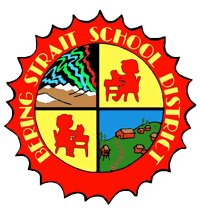Bering Strait School District
Bering Strait School District (BSSD) is a school district in northwestern Alaska, United States, serving approximately 1,700 students in grades K-12 in fifteen isolated villages. All schools in the district serve students of all ages, and most classrooms are multi-age.
Communities
The district covers a roadless area of about 200,000 square kilometres (77,000 sq mi), roughly the size of Minnesota and North Dakota combined. The student population is roughly 98% Alaska Native, including Yup'ik, Siberian Yup'ik, and Inupiat Eskimos. Travel between villages is by air; the nearest road connection to the outside world is almost 300 miles (480 km) east of the district office in Unalakleet.
The communities in the district are traditional Eskimo villages which rely on subsistence activities such as hunting marine mammals and migratory birds, and gathering berries. Native dance and traditional crafts such as walrus ivory carving are still strong. At least four villages practice traditional whaling. There are few cash economy jobs, and the school is often the largest employer in each village.
Russia is visible from four district schools with the naked eye, and from the Diomede School's steerable Dateliner Webcam, so called because the International Date Line is 2.4 km (1.5 mi) from the camera.
The route of the Iditarod Trail Sled Dog Race runs through six district villages, where it is a major event. Many current and former Iditarod mushers live in the district, and participate in school activities focusing on the history and cultural traditions of mushing.
Academics
The district, working with the Alaska Staff Development Network, the Re-inventing Schools Coalition, and the Bill & Melinda Gates Foundation, has created a standards-based curriculum and abolished grade level groupings. Students progress through a mastery-based series of standards levels in ten content areas, rather than traditional subjects, in order to graduate.
All district schools are receiving basic training on how to involve students in adding content to Wikipedia as a meaningful part of classroom instruction, as opposed to simply consuming others' contributions. This focus on Place-Based Education is a priority of the district's leadership.
Wiki-based curriculum system
The district’s OpenContent wiki curriculum project has over 13,815 pages of education standards, curriculum content, staff development tutorials, and various user-oriented pages. Although some pages are very well populated, and some are article stubs, the body of curriculum resources is increasing rapidly. Over 6,224 files have been uploaded, and daily use by students and staff was exponentially increasing as of October 2007.
Nearly all of the organization's teachers, students and administrators have contributed in the first two years of the project. All content is Creative Commons licensed, and editing by educators and interested parties outside the district is encouraged.
Although this is the official curriculum used by the school district's 16 K–12 facilities, outside contributors are welcome. The content changes and talk pages are used by the BSSD Curriculum Advisory Standing Committees to revise and edit the official, standards-based curriculum.
DART: Data Analysis and Reporting Toolkit
In addition, the BSSD has designed, created and released an Open Source standards-based tracking and student information system (SIS) called the Data Analysis and Reporting Toolkit (DART). The latest build completely replaced the district's use of an expensive proprietary student information system (Pearson's PowerSchool) while still remaining free and open under the GPL.
DART directly links the OpenContent project standards information and resources in the its wiki to the individual and group needs so that teachers and learners can plan instruction, identify patterns of strengths and weaknesses, and monitor progress.
The software was built, and is running on the Linux, Apache, MySQL and PHP (LAMP) platform. There are at least eight known installations of the first version released last year, and some are supporting up to 2,300 total users at this time, with up to 15 different school buildings.
Tech support needs have been minimal after initial configuration, and the system is quite stable and intuitive for users.
DART-Wiki Integration
The integration of the BSSD OpenContent Project with DART has changed the way BSSD teachers teach, and students learn.
BSSD welcomes collaboration with other like-minded school districts interested in sharing our collaboratively creating Open Content curriculum products, and Open Source solutions for K-12 users.
DART / Wiki modules have already been built that also monitor:
- Standards Tracking - Group & individual progress monitoring and reporting
- Attendance Data and Reporting
- Discipline Logging
- Dashboard Tool - Tracks overall school progress, attendance, discipline
- State and Federal Programs Data Exports
- Analysis and Data Visualization - links state required testing with standards progress data
- Basic Special Education compliance reporting
- School Improvement Planning & Report Generation
- Success for All (SFA) reading data
- Transcript Creation
Modules are planned or in progress for:
- Special Education Process (Forms & data for referral and IEP monitoring) - This will be directly linked to wiki resources for IEP objective writing and intervention support.
- ePortfolio - Integration with wiki and Moodle with an ePortfolio system, and Career and Technical Education tracking
- School District Report Card (SDRC) - Annual NCLB accountability report generation
Schools
- Anthony A. Andrews School (St. Michael)
- Aniguiin School (Elim)
- Brevig Mission School (Brevig Mission)
- Diomede School (Diomede)
- Gambell School (Gambell)
- Hogarth Kingeekuk Memorial School (Savoonga)
- James C. Isabell School (Teller)
- Koyuk-Malemute School (Koyuk)
- Martin L. Olson School (Golovin)
- Shaktoolik School (Shaktoolik)
- Shishmaref School (Shishmaref)
- Tukurngailnguq School (Stebbins)
- Unalakleet School (Unalakleet)
- Wales School (Wales)
- White Mountain School (White Mountain)
